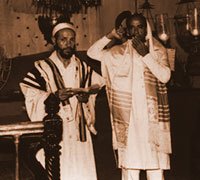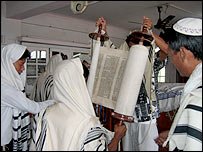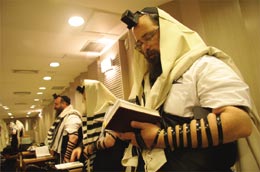Re: Do Muslims hate jews so much, as to
Ashkenazi Jews aren't descendants of Isaac either. Nor Israel. They're just Europeans who converted into Judaism. What makes their claim to Jerusalem legitimate?
Actually your claim is a
myth. I will explain:
Apart from the historical evidence proving that a vast majority of present-day Jews did not descend from the Khazars, there is now also genetic evidence. Among the Jews there is the class of priests called Cohanim who served in the Temple and who now carry surnames such as "Cohen" and many variations on that name. Cohanim comprise of about 5% of the male Jewish population. There are strict rules of marriage for the Cohanim and the title is only passed through the male line. Also, converts cannot become Cohanim (but their children will be if they have a Cohen as a father). The priestly line is descended directly from the Aaron of the bible so it is expected that all Cohanim would carry some common genetic features.
In recently published work (1) it was found that 54% of self-identified Cohanim had common genetic features that were revealed by analysis of their DNA. Specifically, a component of the Y-chromosone, an allele YAP+ DYS19, was identified that showed up only 1.5% of the time in Cohanim but 18.4% of the time in a random selection of non-Cohanim Jews and there were other genetic differences apparent as well. (The same differences were apparent for both Sepphardic and Askhenazic Jews also proving a common origin pre-dating a later split between the two groups.)
The large number of Cohanim among present-day Jews and the fact that they have a common genetic lineage traceable to Israel at the time of the Temple, demonstrates that modern Jews come from a population pool derived from Israel and not from the Khazars. The Khazars could not have developed their own lineage of Cohanim anyway, since being a Cohen is a male-inherited status which converts (the Khazars) could not have obtained.
(1) Skorecki K; Selig S; Blazer S; Bradman R; Bradman N; Waburton PJ; Ismajlowicz M; Hammer MF (1997) Y chromosomes of Jewish priests. Nature, 385:32.
A genetic marker is a variation in the nucleotide sequence of the DNA, known as a mutation. Mutations which occur within genes -- a part of the DNA which codes for a protein usually cause a malfunction or disease, and is lost due to selection in succeeding generations. However, mutations found in so-called "non-coding regions" of the DNA tend to persist.
Since the (male) Y chromosome consists almost entirely of non-coding DNA, it would tend to accumulate mutations. Since it is passed from father to son without recombination, the genetic information on a Y chromosome of a man living today is basically the same as that of his ancient male ancestors, except for the rare mutations that occur along the hereditary line. A combination of these neutral mutations, known as a haplotype, can serve as a genetic signature of a man's male ancestry. Maternal genealogies are also being studied by means of the m-DNA (mitrocondrial DNA), which is inherited only from the mother.
Dr. Skorecki then made contact with Professor Michael Hammer of the University of Arizona, a leading researcher in molecular genetics and a pioneerin Y chromosome research. Professor Hammer uses DNA analysis to study the history of populations, their origins and migrations. His previous research included work on the origins of the Native American Indians and the development of the Japanese people.
A study was undertaken to test the hypothesis. If there is a common ancestor, the Cohanim should have common genetic markers at a higher frequency than the general Jewish population.
In the first study, as reported in the prestigious British science journal, "Nature" (January 2, 1997), 188 Jewish males were asked to contribute some cheek cells from which their DNA was extracted for study. Participants from Israel, England and North America were asked to specify whether
they were a Cohen, Levi or Israelite, and to identify their family background.
The results of the analysis of the Y chromosome markers of the Cohanim and non-Cohanim were indeed significant. A particular marker (YAP-), was detected in 98.5 percent of the Cohanim, and in a significantly lower percentage of non-Cohanim.
In a second study, Dr. Skorecki and associates gathered more DNA samples and expanded their selection of Y chromosome markers. Solidifying their hypothesis of the common ancestor of Cohanim, they found that a particular array of six chromosomal markers were found in 97 of the 106 Cohanimtested. This collection of markers has come to be known as the Cohen Modal Haplotype (CMH) -- the standard genetic signature of the Jewish priestly family. The chances of these findings happening at random is greater than one in 10,000.
The finding of a common set of genetic markers in both Ashkenazic and Sephardic Cohanim worldwide clearly indicates an origin pre-dating the separate development of the two communities around 1000 CE. Date calculation based on the variation of the mutations among Cohanim today yields a
time frame of 106 generations from the ancestral founder of the line, some 3,300 years, the approximate time of the exodus from Egypt, the lifetime of Aaron the Cohen.
TRIBAL DESCENT
Professor Hammer was recently in Israel for the Jewish Genome Conference.
He confirmed that his findings are consistent: over 80 percent of self-identified Cohanim have a common set of markers. The finding that less than one-third of the non-Cohen Jews who were tested possess these markers is not surprising to the geneticists. "Jewishness" is not defined genetically. Other Y chromosomes can enter the Jewish gene pool through conversion or through
a non-Jewish father. Jewish status is determined by the mother. Tribe membership follows the father's family line.
Calculations based on the high rate of genetic similarity of today's Cohanim resulted in the highest "paternity-certainty" rate ever recordedin population genetics studies -- a scientific testimony to family faithfulness.
Wider genetic studies of diverse present-day Jewish communities show a remarkable genetic cohesiveness. Jews from Iran, Iraq, Yemen, North Africa and European Ashkenazim all cluster together with other Semitic groups, with their origin in the Middle East.










